Hyles euphorbiae
|
|
Updated as per personal communication with Tom Middaugh (Hyles euphorbiae, July 21-22, Clay County, South Dakota); July, 2006
Updated as per James P. Tuttle's The Hawk Moths of North America, July 2008
Updated as per personal communication with Ian Miller (Hyles euphorbiae, June 4, 2009, Eau Claire County, Wisconsin); June 2009
Updated for Hyles euphorbiae, Spokane, Spokane, Washington, as per personal communication with David Droppers (BAMONA)
Updated as per personal communication with Edna Woodward, Johnson County, Wyoming, June 24, 2012; June 25, 2012
Updated as per personal communication with Anna Mizyn, mature larva, Lindsay, Ontario, July 6, 2014
Updated as per personal communication with Trina Sweet, mature larva, Antrim County, northern Michigan, September 12, 2015
Updated as per personal communication with Rebecca Hawks, mature larva, Alpena County, northern Michigan, August 18, 2016
|
Hyles euphorbiae
(Linnaeus, 1758) Sphinx euphorbiae
Leafy Spurge Hawkmoth
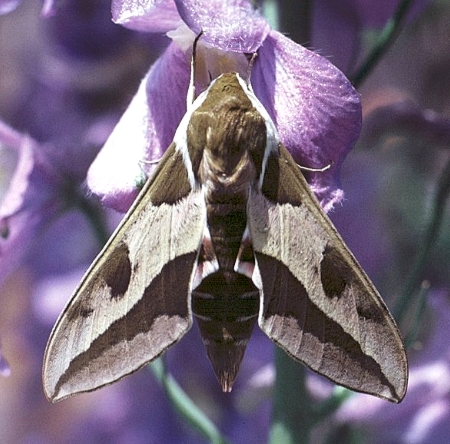
Hyles euphorbiae courtesy of Tony Pittaway.
This site has been created by
Bill Oehlke at oehlkew@islandtelecom.com
Comments, suggestions and/or additional information are welcomed by Bill.
TAXONOMY:
Family: Sphingidae, Latreille, 1802
Subfamily: Macroglossinae, Harris, 1839
Tribe: Macroglossini, Harris, 1839
Genus: Hyles Hubner, [1819] ...........
Species: euphorbiae (Linnaeus, 1758)
|
MIDI MUSIC
.....It's a Wonderful World.....
copyright C. Odenkirk
ON.OFF
<bgsound src="world.mid" LOOP=FOREVER>
|
DISTRIBUTION:
The leafy spurge hawk moth,
Hyles euphorbiae
(length: 2-3 cm, wingspan: 5-7 cm), was the first classical
biological agent released against
leafy spurge in the United States, with approval for
introduction granted in 1965.
Populations of this insect are present in several western states,
including Montana, Idaho, North Dakota, Wyoming, Minnesota and Oregon, and now Washington (Spokane County; David Droppers; BAMONA).
The moth was also introduced from Europe into Ontario, Canada, and
then into Alberta where specimens are occasionally still taken. I
recently received an image of larva (July 2003) from
Neepawa, Manitoba.
On July 25, 2006, I received this email note from Tom Middagh: "Thought you
might be interested. Just got back from a little bug hunting in
Vermillion (Clay County), southeastern South Dakota, July 21 and 22, right on the Missouri River.
We set up a light for a couple nights. I was surprised to see
five Hyles euphorbiae come in and sit on the sheet. I thought
they were gallium but different. When I got home, I had a chance to
take a closer look at the specimens and IDed them as
H. euphorbiae."
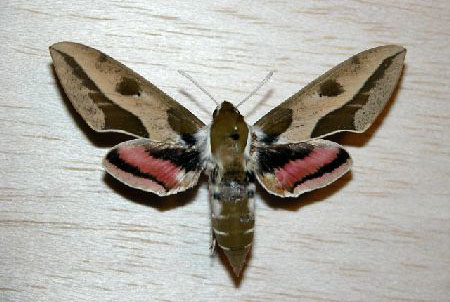
Hyles euphorbiae, courtesy of Tom Middagh.
In late July-early August of 2007, I received images of larvae from
Saskatchewan and southwestern Iowa.
Bonnie Hickey (Cashman Nursery), writes, August 2, 2007, "I have
enjoyed watching these caterpillars on my
Euphorbia mysinites in my yard in Bozeman (Gallatin County),
Montana, for the past several summers. They do not feed on the
Euphorbia polychroma or griffithii, however. I was
planning to remove some of the Euphorbias but have decided to
control seedlings with Preen instead so that I can continue to
watch all the color stages of these caterpillars in future years!"
Visit Hyles euphorbiae, Eau Claire, Wisconsin, June 3-9, 2009, courtesy of Ian Miller.
It has now also been confirmed in northern Michigan.
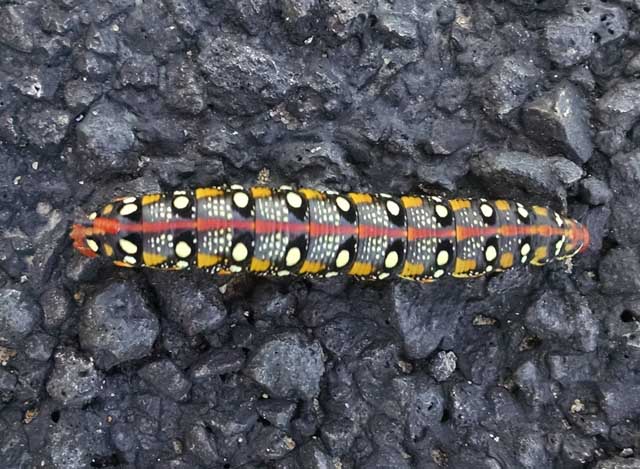
Hyles euphorbiae fifth instar, Antrim County, Michigan,
September 12, 2015, courtesy of Trina Sweet.
The body is light brown with various white and dark brown markings, while the wings have a conspicuous tan, brown,
and pink or red color pattern. The upperside of the hindwing is a rosy-pink. There is a great deal of variation among the
adults. | 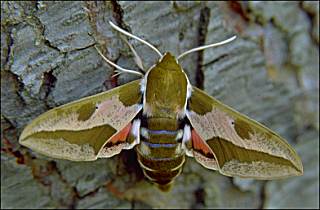 |
Originally this species occurs from south and central Europe to central Asia. It was released in Ontario on
cypress spurge in 1965 with stock collected in eastern
Germany and was subsequently redistributed within North America after
screening by Agriculture Canada.
In mid July, 2003, I received images of Hyles euphorbiae larvae
from Bismarck, North Dakota, and Innis Point, Ontario, just west of Ottawa.
Tony Pittaway writes, "From western Europe (Portugal (Corley, 2004)), and southern and central Europe to the Urals (Kumakov, 1977; Nupponen & Fibiger, 2002),
southern western Siberia (Zolotarenko, Petrova & Shiryaev, 1978; Izerskiy, 1999), the western fringes of the Altai Mountains (Izerskiy, 1999) and
western China (Xinjiang Province). Also, Turkey (Daniel, 1939; de Freina, 1979) Transcaucasia, northern Afghanistan (Ebert, 1969), Kyrgyzstan (S. Toropov, pers. comm.)
and the western Tian Shan (Alpheraky, 1882; Derzhavets, 1980). Not found in Corsica, Sardinia or the Balearic Islands (Pittaway, 1983b). A migrant to the north.
"It should be noted that some populations in Portugal and southwestern Spain appear to be hybrids of this species and Hyles tithymali gecki."
Reinhart Roehrig indicates it flies in northern Africa.
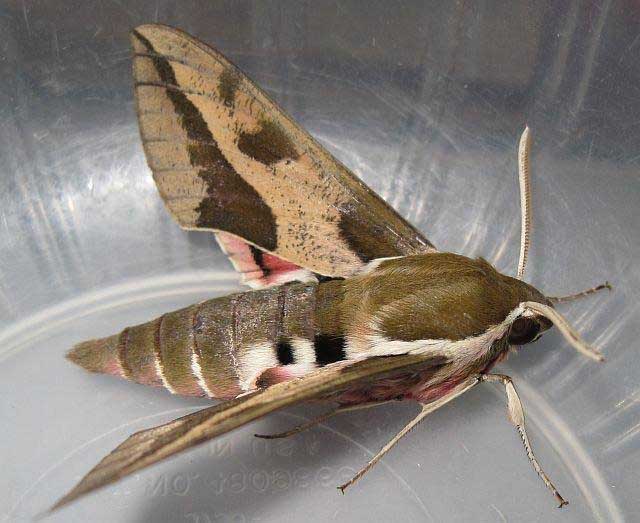
Hyles euphorbiae, Johnson County, Wyoming,
June 24, 1012, courtesy of Edna Woodward.
FLIGHT TIMES:
These day-flying moths often exhibit a hummingbird-like flight while visiting
flowers in leafy spurge-infested grasslands beginning in early to mid-summer. There are either one (Ontario) or two
broods annually in the U.S.
ECLOSION:
Pupae probably wiggle to surface from subterranean chambers just prior to eclosion.
SCENTING AND MATING:
Females call in the males with a pheromone released from a gland at the tip of the
abdomen.
EGGS, LARVAE AND PUPAE:
After mating, females lay small clusters of eggs, up to 50, on
leafy spurge foliage. After hatching, larvae consume leafy spurge leaves and flowers. |
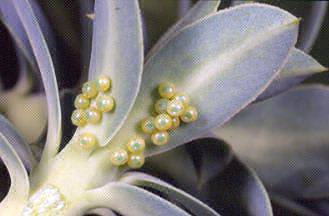 |
H. euphorbiae larvae are found feeding on leafy spurge leaves. The
caterpillars are also conspicuously colored, with a
pronounced tail or "horn" near the rear end.
Young larvae are variously patterned with green, yellow, and black; older
larvae have a distinctive red, black, yellow, and white color pattern. Mature larvae may approach 10 cm in length; when
disturbed, they regurgitate a slimy green liquid. Image courtesy of Tony Pittaway. |
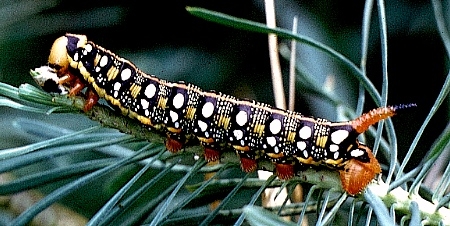 |
The host range of H. euphorbiae appears restricted to plants in the subgenus Esula of the genus
Euphorbia.
In Europe, this insect feeds on leafy spurge and several other closely-related spurge species. There are a few native
Euphorbia spp. in the U.S. that could potentially be hosts for H. euphorbiae, though no feeding has yet
been
documented under field conditions. H. euphorbiae will not feed on poinsettia (Euphorbia pulcherrima), and
crop
species and native plants outside the genus Euphorbia will not be attacked.
Pupae are 3.5-5 cm long and dark brown, and are found just below the soil surface where it tolerates -21°C. Pupae are
prone to predation by mice. |  |
H. euphorbiae larvae defoliate leafy spurge plants, but this damage seems to have little or no impact on spurge
populations. In addition, hawk moth populations generally remain low in an area, due to predation and disease.
Thus, H. euphorbiae plays only a very minor role in leafy spurge biological control.
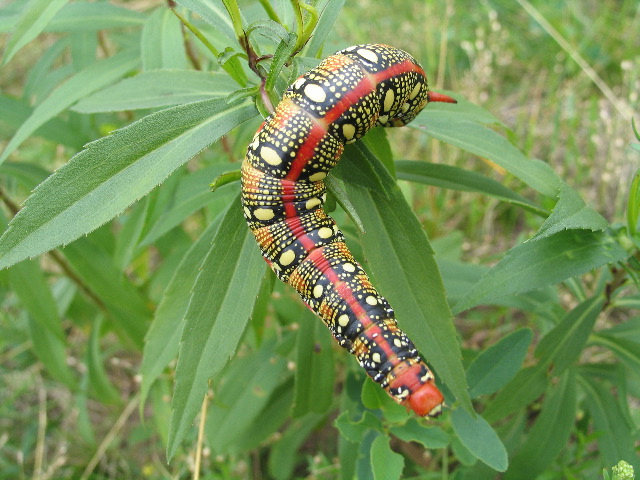
Hyles euphorbiae, Innis Point, Ontario, July 20, 2003, courtesy of Bill Petrie.
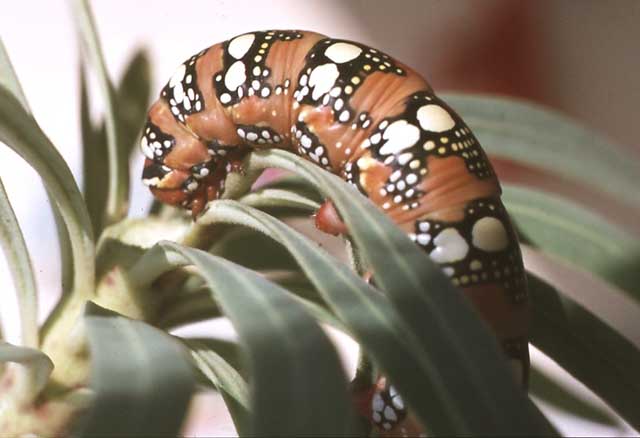
Hyles euphorbiae, LeLavandou, France, June, 1981, courtesy of Reinhart Roehrig.
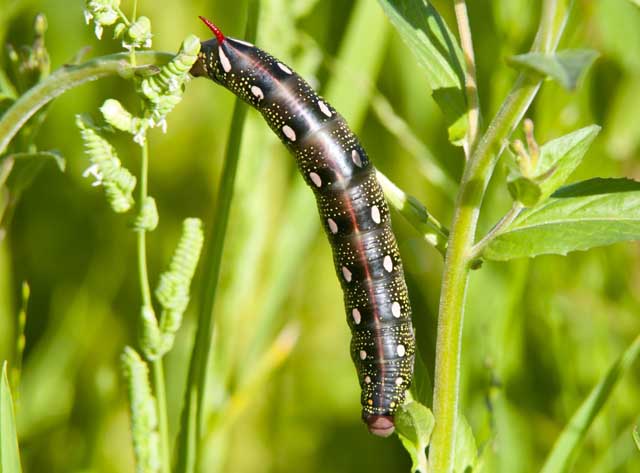
Hyles euphorbiae (possibly gallii), Calgary, Alberta, July 27, 2012, courtesy of Don Hladky.
Visit Hyles euphorbiae prepupal larva, near Lethbridge, Alberta, August 2, 2012, Justine Willis
Visit Hyles euphorbiae larva, Winnipeg, Manitoba, September 10, 2013, Carroll Maxwell
Visit Hyles euphorbiae larva, Lindsay, Ontario, July 6, 2014, Anna Mizyn
Visit Hyles euphorbiae, near Rundle Park, Edmonton, Alberta, July 25, 2014, Telofson
Use your browser "Back" button to return to the previous page.
Goto Main Sphingidae Index
Goto Macroglossini Tribe
Goto Central American Indices
Goto Carribean Islands
Goto South American Indices
Goto U.S.A. tables
Enjoy some of nature's wonderments, giant silk moth cocoons.
These cocoons are for sale winter and fall. Beautiful Saturniidae moths will emerge the following spring and summer.
Read Actias luna rearing article. Additional online help available.
Use your browser "Back" button to return to the previous page.
This page is brought to you by
Bill Oehlke and the
WLSS. Pages are on space rented from Bizland. If you would like
to become a "Patron of the Sphingidae Site", contact Bill.
Please send sightings/images to Bill. I will do my best to respond to requests for identification help.
 | 
Show appreciation for this site by clicking on flashing butterfly to the left.
The link will take you to a page with links to many insect sites. |












